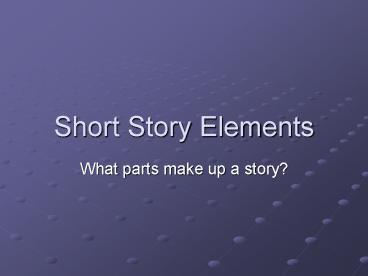Short Story Elements - PowerPoint PPT Presentation
1 / 20
Title: Short Story Elements
1
Short Story Elements
- What parts make up a story?
2
Story Terms
- Plot
- Setting
- Characters
- Point of View
- Theme
3
Plot
- Plot is what happens and how it happens in a
narrative. - A narrative is any work that tells a story, such
as - a short story
- a novel
- a drama
- a narrative poem
4
Parts of a Plot
- Exposition - event that gives rise to conflict
(opening situation) - Rising Action - events that complicate or
intensify the central conflict (rising action) - Climax - highest point of interest or emotional
involvement in the story - Falling Action - logical result of Climax
- Resolution - Final outcome of the story
5
Conflict
- Conflict is a struggle between opposing forces
- Every plot must contain some kind of conflict
- Stories can have more than one conflict
- Conflicts can be external or internal
- External conflict- outside force
- may be person, group, animal, nature, or a
nonhuman obstacle. - Internal conflict- takes place in a characters
mind
6
Diagram of Plot
7
Special Techniques of Plot
- Suspense- excitement or tension
- Foreshadowing- hint or clue about what will
happen in story - Flashback- interrupts the normal sequence of
events to tell about something that happened in
the past - Surprise Ending- conclusion that reader does not
expect (use of irony)
8
Setting
- Time and place are where the action occurs
- Details that describe
- Furniture
- Scenery
- Customs
- Transportation
- Clothing
- Dialects
- Weather
- Time of day
- Time of year
9
Elements of Setting
10
The Functions of a Setting
- To create a mood or atmosphere
- To show a reader a different way of life
- To make action seem more real
- To be the source of conflict or struggle
- To symbolize an idea
11
Example
- We left the home place behind, mile by
slow mile, heading for the mountains, across the
prairie where the wind blew forever. - At first there were four of us with one
horse wagon and its skimpy load. Pa and I walked,
because I was a big boy of eleven. My two little
sisters romped and trotted until they got tired
and had to be boosted up to the wagon bed.
- That was no covered Conestoga, like Pas
folks came West in, but just an old farm wagon,
drawn by one weary horse, creaking and rumbling
westward to the mountains, toward the little
woods town where Pa thought he had an old uncle
who owned a little two-bit sawmill. - Taken from The Day the Sun Came Out by D.
Johnson
12
Types of Characters
- People or animals
- Major characters
- Minor characters
- Round characters
- Flat characters
13
Elements of Character
14
Characterization
- A writer reveals what a character is like and how
the character changes throughout the story. - Two primary methods of characterization
- Direct- writer tells what the character is like
- Indirect- writer shows what a character is like
by describing what the character looks like, by
telling what the character says and does, and by
what other characters say about and do in
response to the character
15
Direct Characterization
- And I dont play the dozens or believe in
standing around with somebody in my face doing a
lot of talking. I much rather just knock you down
and take my chances even if Im a little girl
with skinny arms and a squeaky voice, which is
how I got the name Squeaky. - From Raymonds Run by T. Bambara
16
Indirect Characterization
- The old man bowed to all of us in the room. Then
he removed his hat and gloves, slowly and
carefully. Chaplin once did that in a picture, in
a bank--he was the janitor. - From Gentleman of Rio en Medio by J.
Sedillo
17
Characterization
- A writer reveals what a character is like and how
the character changes throughout the story. - Two primary types of character
- Flat- reveals only one or two traits.
- Round- reveals varied and sometimes contradictory
traits.
18
Factors in Analyzing Characters
- Physical appearance of character
- Personality
- Background/personal history
- Motivation
- Relationships
- Conflict
- Does character change?
19
Theme
- A central message, concern, or insight into life
expressed through a literary work - Can be expressed by one or two sentence statement
about human beings or about life - May be stated directly or implied
- Interpretation uncovers the theme
20
Example of Theme
- Every man needs to feel allegiance to his native
country, whether he always appreciates that
country or not. - From A Man Without a Country by Edward
Hale































